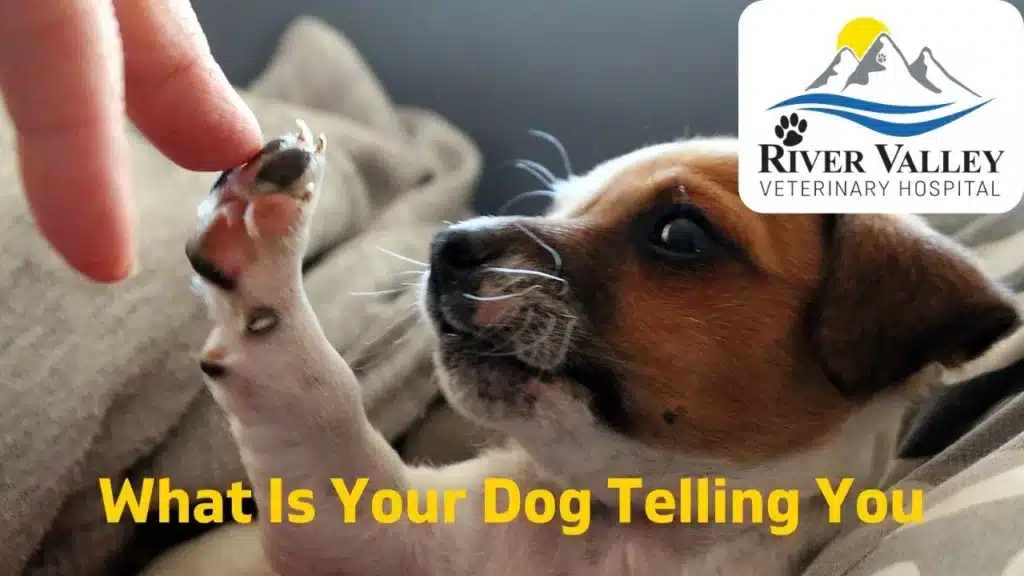Veterinarian in Fox Chapel | What Is Your Dog Telling You Part 2
In part one of our dog body language series, Richard Linkenheimer, the expert veterinarian at veterinarian in Fox Chapel clinic, River Valley Veterinary Hospital. With his decades of experience as a veterinarian and pet owner, he’s learned to read pet body language and will share his insight with us today. While in part one we learned about what a dog’s head and mouth say, we will learn about ears, eyes and the tail!
Ears Say A Lot
Ears can be quite easy to read, says veterinarian Fox Chapel, especially when combined with looking at their other body language. While dogs with particularly floppy ears may be known as “speaking with an accent”, get to know your own dog, and the positions of their ears to know what they are saying. Generally, ears that are erect indicate a happy dog, if they are erect and also slightly forward, indicate the animal is alert and attentive. Ears pulled back indicates the dog is scared or mad – look at the rest of their body and head to understand what it is they are saying.
Ears that are back, but splayed indicate a dog is uneasy. Perhaps unsure about the situation, and may look to your behavior to figure out how they should act. When a dog’s ears are pressed flat to their head indicates fear or frustration. And when one ear is alert, the dog is listening carefully. Again, make sure you look at ears alongside head, mouth, body and tail position to truly understand what the dog is saying. Again, if your dogs ears are extra large and floppy, like a beagle, or cocker spaniel or any of the nine different ear shapes dogs have you may have less range of motion to watch for. But it’s still possible to tell what your pup is indicating with their ears if you’re paying attention.
Veterinarian in Fox Chapel | Eyes Are The Window To the Soul
Do dogs use their eyes to communicate? You bet they do, says veterinarian in Fox Chapel. In fact, dogs’ eyes are very expressive and communicative! Their eyes indicate their emotional state with either “hard” eyes or “soft eyes”. Soft eyes are used when a dog is happy and calm. Their eyes will be slightly alert and watching, but not using direct eye contact. Happy, unconcerned dogs are blinking often, and watch for long, slow blinks. That’s a dog communicating their love for you.
Hard eyes have their eyes slightly closed with a wrinkled brow, perhaps they are also baring their teeth. They will be looking directly at any perceived threat and possibly using direct eye contact. If a dog has “hard eyes” remove them from the situation if possible, or use a calming signal, blink and break eye contact, casting your eyes down to tell the dog that you are no threat.
The Dog With the Waggly Tail
This is potentially the dog body language that most people are familiar with! People usually know that a waggly, wiggly tail is on one end of a happy dog, says veterinarian in Fox Chapel. However, are people equally as knowledgeable about other tail signals? There are so many varying positions and movements, that an entire article could be devoted to it, but here are the basics. Fast wagging indicates an excited dog, a slower broad tail wag is friendly and happy. If the tail is loosely hanging, not wagging – that is a sign of a happy, relaxed dog. But if the tail is not moving, and also tucked between their legs, could indicate fear and anxiety or apprehension or insecurity.
A dog’s tail held up is the signal of a confident dog, and when their tail is pointing vertically out, they are nervous, threatened or feeling anxious. Again, says veterinarian in Fox Chapel, there are so many types of tail movements that indicate varying degrees of these feelings, that it’s best to get to know your own dog. And since dogs have many different sizes of tails, and some breeds have the tails docked, the tail motions may be a little bit harder to interpret – like the ears. Also use the dog’s other bodily cues to truly understand what the dog is communicating.
Get To Know Your Own Pet
This is just a small example of how you can start to learn what your dog is saying. There are also body positions, a dog’s vocalizations such as their barks, growls and whimpers says veterinarian in Fox Chapel. There is also specific behaviors and actions like panting, sighs, sneezing, sniffing and snuffling and more. However, don’t only rely on your pets body language to understand how they feel. It’s important you bring them in to a great vet – like River Valley Veterinary Hospital once a year for their annual check up. They will find out what’s going on with your dog internally, so all you have to concentrate on is giving them all the love you can.

